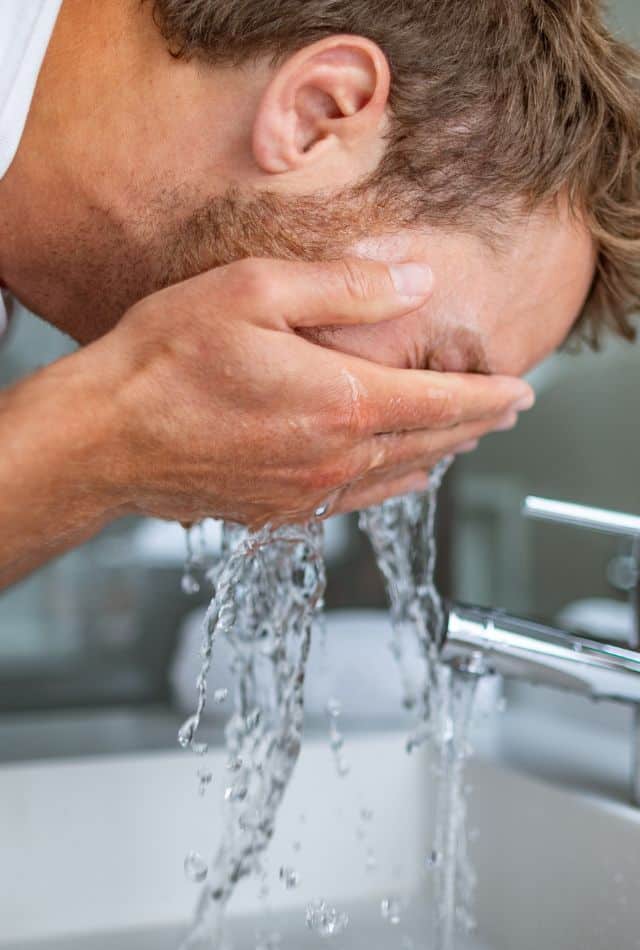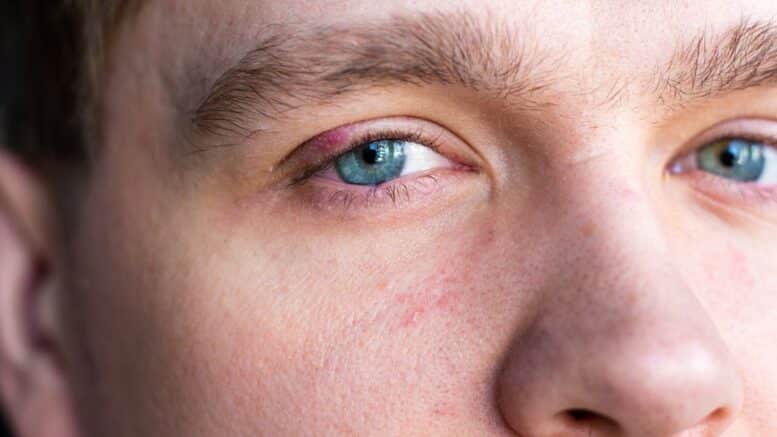What Causes Frequent Eye Styes? – Introduction
If you keep getting styes then you’re not alone. Styes are painful, tender red bumps that form on or around the eyelid. Certain bacterial infections can cause them. They can develop internally or externally. They are discomforting and frustrating when they keep occurring frequently.
Removing the underlying causes of styes and implementing preventive measures can help to manage and minimize their recurrence.
In this article, you will explore styes, their types, risk factors associated with their recurrence, their pathophysiology, preventive measures, and treatment options as well.
Overview Of Styes
Styes or hordeolum are bacterial infections affecting the eyelid. The clogged oil or sweat glands in the eyelids result in the development of styes (1). They occur at the base of eyelids, eyelash follicles, or in the oil glands. Styes are discomforting due to swelling and tenderness in the affected area. They do not cause severe harm and resolve automatically within a few days or weeks (2).
Types Of Styes
Internal Stye
Internal styes, or internal hordeolum, occur at the edge of the eyelids. They affect the oil-producing meibomian glands inside the eyelid. Meibomian glands secrete lubricating oil inside the eye. These glands get clogged and form pus (abscess), ultimately developing a swollen, painful area on the inner side of the eyelid. They are not visible since internal styes develop under the eyelid’s surface (3).
External Stye
An external stye is the most common type, a swollen, red bump resembling a pimple. It occurs at the outer edge of the eyelid, along the base of an eyelash. They happen due to sweat or oil gland infections. They appear as a red, swollen bump resembling a pimple or boil (3).
Risk Factors Associated With Recurrent Styes
A recurrent stye is one that repeatedly occurs over time, even after resolution. It is a discomforting medical condition to deal with and has several possible causes (2, 4):
1. Poor Eyelid Hygiene
Poor cleaning practices of the eyelids and lashes can accumulate bacteria, dead skin cells, and oils. In this case, a favorable environment is conducive to stye formation.
Inadequate eye makeup removal increases bacterial growth and enhances the chances of styes.
2. Cosmetic Product Usage
Expired or contaminated eye makeup products become infected with bacteria, leading to stye development. Eye makeup should not be shared with others because it can spread bacteria and contribute to recurrent styes.
3. Contact Lens Wear
Poor or inadequate maintenance of contact lenses can increase the risk of stye recurrence. Dirty or expired lenses, improper lens cleaning, and disinfection can hinder oil flow inside eyelids and contribute to bacterial contamination.
4. Compromised Immune System
A weakened or compromised immune system increases the susceptibility to infections, including styes. The immune system becomes weak due to chronic illness, stress, or certain medications.
5. Rubbing or Touching Eyes
Certain gems accumulate on hands when they are washed improperly. Frequent rubbing or touching of the eyes with dirty hands can result in stye development.
6. Pre-Existing Eye Conditions
A medical condition known as blepharitis (inflammation of the eyelid margin) or meibomian gland dysfunction can be a reason of recurring styes.
7. Underlying Medical Conditions
Diabetes, rosacea, or hormonal imbalances are associated with recurrent styes development.
8. Other Risk Factors
Other factors can include a previous or family history of styes, exposure to certain allergic contents or dust, and even smoking can also contribute to stye development.
The Mechanism of Development of Styes
The mechanism behind the development of styes is due to infection of eyelids caused by a bacteria known as Staphylococcus aureus. The blocked gland assists bacterial growth and subsequent infection. Our body’s immune system starts an inflammatory reaction noticed by redness, swelling, pain, and pus formation (abscess) (5).
Preventive Measures
The following can be preventive measures (6):

Why Do I Keep Getting Styes – Preventive Measures
Proper Eyelid Hygiene Practices
Regular eyelid cleansing can help remove debris and excess oil. Cleansing with normal saline, tear-free cleanser, or pharmaceutical eye products is advisable. Dilute these with warm water and scrub gently. Use a soft washcloth to tap dry after cleansing. Do not rub or scratch, as violent scrubbing can irritate your eyelids.
Before bedtime, remove all of the eye makeup. Use makeup wipes cause they are designed for eyelid cleansing.
Avoidance Of Cosmetic Product Contamination
Note the expiry of mascara, eyeliner, and eyeshadow regularly. Close the container tightly; open containers can harbor bacteria fastly. Avoid sharing your cosmetics with others, and clean brushes and applicators regularly. Product residues provide a favorable environment for microbes.
Safe Contact Lens Practices
Before applying lenses wash your hands with soap and water. Follow the disinfection guidelines provided by the eye care professional. Avoid reusing the same cases and solutions from previous uses. Do not sleep wearing your contact lenses unless your eye care specialist instructs you.
Boosting Immune System Health
Try eating a balanced diet containing high content of fruits, vegetables, and whole grains. Maintain a healthy lifestyle by getting regular exercise. Stay calm and have sufficient sleep. If you have any underlying medical condition that may compromise your immune system, your doctor can assess your condition and guide you in your treatment options.
Treatment Options For Styes
Treatment options include (7):
At Home
Warm Compresses
Use a clean washcloth to apply a warm compress to the eyelid. Keep the warm compress for 10 to 15 minutes multiple times a day. The warmth increases the blood movement to the affected area and helps drainage easing discomfort due to styes.
Avoid too hot a compress as there are chances of skin burning.
Eyelid Hygiene
Hygiene involves cleaning the eyelid with a mild, non-irritating cleanser, normal saline, or pharmaceutical eye products. To remove debris or crust from the affected eyelid, use a clean washcloth and gently clean the base of the eyelashes and affected eyelid. Do not squeeze or pop the stye to avoid further infection.
Medical Treatment:
Topical Antibiotics
Eyecare providers assess the condition and can prescribe antibiotic ointments for the affected eyelid. Antibiotic ointments or drops stop bacterial infection and promote healing.
Apply the antibiotic ointment or drops as instructed by your healthcare provider regarding the frequency and duration.
Steroid Ointments
According to the severity of the stye healthcare provider prescribes steroid ointments to reduce inflammation and swelling. Due to the severe and long-lasting side effects of steroid ointments, they should only be used under strict medical supervision.
Surgical Intervention
Incision And Drainage
If a stye does not respond after traditional treatment and becomes large, then a minor incision and drainage surgery is performed. A small incision drains the pus and relieves pressure over the eyelids. Local anesthesia is given to provide immediate pain relief.
Removal Of Internal Stye
Internal styes are hard to resolve by other treatments than surgical removal. An ophthalmologist performs surgery and removes the internal stye.
The decision of surgical removal varies case-by-case, depending on the severity and impact on vision.
When To See A Doctor
It is recommended to consult a doctor if you are experiencing a stye that does not improve over time. Mostly styes resolve on their own with self-care at home.
If the known home remedies for stye don’t ease the severe pain, it is advisable to seek medical attention. Significant swelling or vision changes require prompt medical attention.
Those frequently experiencing styes should consult a healthcare professional. They can evaluate the underlying causes and guide preventive measures to reduce the likelihood of future episodes.
If a stye significantly interferes with your daily activities or causes considerable discomfort, seek medical advice for appropriate treatment. Remember that healthcare professionals such as ophthalmologists or primary care physicians are best equipped to provide an accurate diagnosis and treatment plan for your situation. (8)
Summary
Styes are common eye conditions characterized by painful red bumps on the eyelid. They tend to manifest internally or externally while possessing the capacity for repeated appearances. Various risk factors, including poor maintenance of eyelid hygiene, usage of cosmetic products, use of contact lenses without precautionary measures, suppression in immune function, and persistent rubbing/touching/irritation inflicted upon the eyes, are among the contributing factors. Styes develop when bacteria, such as Staphylococcus aureus, infect the eyelid glands. This prompts an inflammatory response, leading to redness, swelling, and pus formation.
Those afflicted by styes can self-care at home, which primarily involves warm compresses in conjunction with optimal maintenance of eyelid hygiene. The prevailing alternative medical treatment options are topical antibiotics alongside steroid-based ointments to eradicate infections while reducing inflammation. In exceptional circumstances, surgical intervention may be recommended—specific incisions followed by drainage processes or, conversely, total removal of an internal stye.
Drawing attention toward seeking timely medical attention remains acutely advisable when no considerable improvements are observed within a few days. This approach will ensure effective handling/resolution of stye, promoting overall eye health.
See Also
How to Remove Eyelash Extensions?
Allergic Reactions to Eyelash Extensions
References:
- Stye [Internet]. nhs.uk. 2017 [cited 2023 Jul 3]. Available from: https://www.nhs.uk/conditions/stye/#:~:text=Styes%20are%20often%20caused%20by
- Lindsley, K., Nichols, J. J., & Dickersin, K. (2017). Non-surgical interventions for acute internal hordeolum. The Cochrane database of systematic reviews, 1(1), CD007742. Non‐surgical interventions for acute internal hordeolum – Lindsley, K – 2017 | Cochrane Library
- Stye – EyeWiki. (n.d.). https://eyewiki.aao.org/Stye
- Institute for Quality and Efficiency in Health Care (IQWiG). (2019, December 5). Styes and chalazia (inflammation of the eyelid): Overview. InformedHealth.org – NCBI Bookshelf. https://www.ncbi.nlm.nih.gov/books/NBK557372/
- Willmann D, Patel BC, Melanson SW. Stye [Internet]. Nih.gov. StatPearls Publishing; 2019 [cited 2023 Jul 4]. Available from: https://www.ncbi.nlm.nih.gov/books/NBK459349/
- Bragg KJ, Le PH, Le JK. Hordeolum. 2022 Aug 14. In: StatPearls [Internet]. Treasure Island (FL): StatPearls Publishing; 2023 Jan–. PMID: 28723014. https://www.ncbi.nlm.nih.gov/books/NBK441985/
- COPEMAN P. W. (1958). Treatment of recurrent styes. Lancet (London, England), 2(7049), 728–729. Treatment of recurrent styes – PubMed (nih.gov)


Follow us